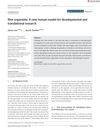Characterization of the Epidermal-Dermal Junction in hiPSC-Derived Skin Organoids
May 2022
in “
Stem cell reports
”
epidermal-dermal junction hiPSC-derived skin organoids hair-bearing skin organoids interfollicular epidermis basal keratinocytes basement membrane laminin-332 type IV collagen type I hemidesmosomes integrin β1-based adhesion complexes type VII collagen epidermolysis bullosa skin organoids stem cell-derived skin basal skin cells skin basement membrane laminin collagen hemidesmosomes integrin collagen VII EB
TLDR The study created hair-bearing skin models that lack a key protein for skin layer attachment, limiting their use for certain skin disease research.
The study successfully created hair-bearing skin organoids from two human induced pluripotent stem cell (hiPSC) lines, which formed a fully stratified interfollicular epidermis. The basal keratinocytes in these organoids adhered to a basement membrane rich in laminin-332 and type IV collagen via type I hemidesmosomes and integrin β1-based adhesion complexes. However, the epidermal-dermal junctions (EDJs) in the organoids were almost devoid of type VII collagen, a fibril that mediates the anchorage of the epidermis to the dermis. This absence of type VII collagen is significant as it suggests that these organoids may not be fully mature and should be considered when using skin organoids for modeling diseases like epidermolysis bullosa, which affects 1 in 30,000 people worldwide and results from perturbed expression and/or structure of components of the EDJ.






